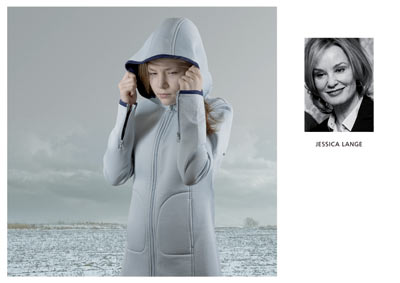23/11/2009
Barbora Žùrková, Radim Žùrek: The Replacement
 |
19th Month of Photography in Bratislava, Galéria Artotéka, Kapucínska 1, Bratislava, November 6-30, 2009
Barbora Žůrková and Radim Žůrek have recently made a vibrant and significant appearance at the Czech photographic scene. Today, along with Dita Pepe, Barbora Kuklíková, Radeq Brousil, Štěpánka Stein with Salim Issa, Kateřina Držková, Jan Faukner, Barbora Bálková, Tereza Vlčková and others, they belong to those young Czech photographers who have succeeded in precisely addressing topical creative tendencies and creating clear-cut, conceptually stable, unique, visually strong and technically perfect works that reach out to a wide audience. Similarly to most of the above mentioned photographers, the Žůreks are not afraid to come to a fusion of the „fine“ and „degraded“ arts and look for inspiration outside of the ghetto of traditional photography in film, music, literature, visual art as well as in fashion or advertizing. Alike a growing number of young artists, they masterly handle possibilities offered by digital manipulation with photographic images. Instead of traditional capturing the real world and its inhabitants which prevailed in photography for the first hundred and fifty years of its existence, they create pictures belonging to a non-existent world and artificially made people, a world in which the reality and fiction can no longer be told apart. Although, nowadays, photography has lost its aura of trueness, which it actually never fully bore before, it has become unlimited means to portraying visions that don’t depend on concrete objects.
 |
.jpg) |
Identity and typology are among the most frequented topics of current digitally manipulated photography. Since Nancy Burson joined together portraits of various dictators, movie actresses or American presidents which were not perfect in a technical sense, and then, out of their projection she would create a kind of averaged-out typological studies, digital technologies have rapidly advanced ahead. Today, digital technologies enable anthropologists as well as artists to create pictures of “typical” French women comprised of thousands of different portraits, and thanks to the technologies Yasamusa Morimura can make himself a part of paintings by old and new masters, while Tereza Vlèková is able to create phantom-like portraits of doublets of girls who might be either real twins or clones.
It is the motifs of clones and genetic relations that interest Barbora and Radim Žùrek very much. Their series Descendants with which the couple first attracted attention during their studies at the Institute of Creative Photography, Silesian University, Opava, already showed fictive children whose mother was Barbora, changing her likeness in a chameleon like way, and whose fathers were different men, including her own husband. At first sight, the comparative triplets of portraits seem to be only an entertaining game during which typical features of alleged parents join together in faces of non-existent adolescent children who have been formed in a computer. However, it not a mere play with genes for us to be entertained by comparing appearance of generated young males and females with the likeness of their alleged mothers and fathers. The artists deliberately disrupt the game when they show children in their early twenties which doesn’t correspond with the age of the alleged parents who are sometimes only a few years older than the children. Barbora Žùrková, who represents the mother in the triplets and whose features can be found in all the descendants, is only twenty years old (the Žùreks themselves are curious how much their real little daughter will take after the teenager who they have created digitally). The artists work with more profound intention as they explain: “With the help of computer assemblage we have tried to look for a broader picture of who we are, what we are about, who we used to be and who we could become.” The Žùreks bring a new dimension to their project by putting up these portraits of non-existent people on different web sites that post personals ads.
The couple’s latest series called The Replacement also bears more profound sociological and psychological undertone. So far, it is undoubtedly the highlight of their career which includes other works (e.g. a series of expressive portraits of blind people called The Blind that was awarded at the photography contest Czech Press Photo). In empty landscapes with low horizon where the sky is cloudy, Barbora and Radim Žùrek portray girls and boys at the threshold of adolescence whose faces (that are appropriately adjusted in a computer) remind us of child likeness or clones of many celebrities, universally known from TV screens or newspapers and magazines – actors, Harrison Ford, Al Pacino or Christopher Walken, actresses, Penélope Cruz, Joan Collins and Jessica Lange, a supermodel, Claudia Schiffer, footballers, Pelé and Pavel Nedvìd, a singer, Björk, the “pop king” Michael Jackson, a tennis player Boris Becker and even Wolfgang Amadeus Mozart. First of all, the viewer’s eye is drawn to the perfect technical and artistic execution of idyllic portraits of girls and boys on the brink between childhood and adolescence, between innocence and yet suppressed erotic desire. In spite of the presence of fine clothing, fine hairdos and the digitally accentuated likeness of these girls and boys to truly resemble the self-assured famous and rich, uncertainty, confusion and melancholy emanate from those angel-like and beautiful faces. Sad landscapes where there is no sun and dull colors augment the particular atmosphere. Thus, the Žùreks point out tension which exists between the original persona and his or her clone. We cannot be sure whether these are celebrities’ child portraits or their clones or adolescents who try their best to look like their idols (think about how many could be seen during the media craziness after Michael Jackson’s death). We are left uncertain, yet the artists encourage us to think about more general psychological issues as they state: “The confrontation of a clone and its original’s co-existence versus a child and a mother‘s (father‘s) co-existence opens up an issue regarding a degree of maturity in a man to accept himself as his own replacement, to accept his own clone in his personal environment of relationships he has been building for a long time, and, to possibly face desire to maintain private identity and uniqueness.”
Both the Žùrek’s series have drawn attention at a number of exhibitions in the Czech Republic as well as abroad, for example, at a photography biennale in Lyon, France, at the Festival of Art Photography in Warsaw, or at a Budapest’s Spring Festival. Their series The Replacement was chosen for a prestigious touring exhibition of the most talented young contemporary photographers called Generation 2: Tomorrow’s Photographers Today held by the Museum ¾Elysée in Lausanne, Switzerland, and their work is presented in a book bearing the same title, released by a famous publishing house Thames and Hudson. Barbora and Radim Žùrek have appeared on the Czech photographic scene like a comet would in the sky, however, their work possesses all significance to make sure they will stay there and they won’t disappear.
Vladimír Birgus

